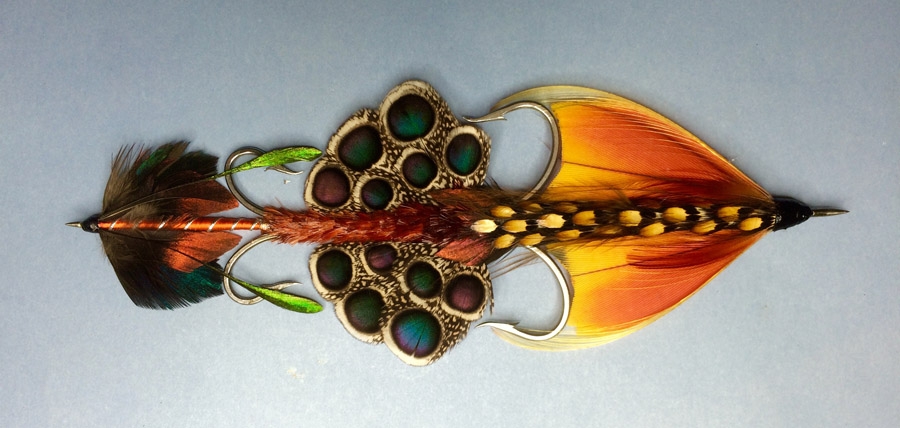Do you really know GEM Skues?

Almost every fly fisher will have heard of GEM Skues, the father of nymph fishing as we now know it. So let’s test your knowledge of this man. Answers at the end of this newsletter.
Was he born in London, Winchester, Ireland or Newfoundland?
Was he educated at Harrow, Winchester or Rugby School in London?
He was known for his excellent eyesight. Yes or no?
Did he ever visit South Africa? Yes or no.
Was he a butcher, an attorney or an auditor, and where did he live his entire business life?
He died aged 61, 78 or 91?
He designed the PTN nymph. Yes or no?
He was a prolific writer whose nom de plum (or noms de plume) was/were, Val Conson, Spent Naturalist, Integer Vitae, WAG?
He was introduced to Frank Sawyer? Yes or no?
Theodore Gordon who fished the Catskills in the USA, wrote to Skues the day before he died. It was the last letter Theodore Gordon ever wrote. True or false?
A fly for art’s sake
In a previous newsletter I showed Ruhan Neethling’s rendition of a fly for art’s sake, his contribution to the Classic Fly Tying challenge. The idea of the challenge is that there are no rules. The tyer just selects a song he or she likes from Pink Floyd’s The Wall album, uses imagination, and sets the song to fur and feathers in classic salmon-fly style. I think it is a brilliant concept. Here is the link to it on the Classic Fly Tying Forum:
http://www.classicflytying.com/index.php?showtopic=54313&hl=
Click in images to enlarge them

Ruhan’s brilliant fly based on the song ‘Another Brick in the Wall Part 3’.
Yesterday I got Matt Zilliox’s delightful entry. Matt lives in the town of Grants Pass in Oregon on the banks of a steelhead river.

Matt Zilliox’s fly from the song ‘Nobody Home’
(These guys are simply brilliant artists with fur and feather.)
Ed Herbst writes on interesting fly-pattern developments from Alan Hobson
Says Ed:
Alan has recently returned from a trip to Harrismith in the Orange Free State where he fished that legendary yellowfish venue, Sterkfontein Dam. While there, he visited the equally legendary Dr Hans van Zyl, creator of The Good Doctor’s Beetle and Alan says he has found a way of adding iridescence to his imitation of a peacock green terrestrial beetle that are blown onto the water in substantial numbers. It follows the basic formula of Van Zyl’s pattern with its innovative use of ‘Seal Skin’ decoupage.

The Good Doctor’s beetle in gold and black – Photo per Gerhard Laubscher
http://www.tomsutcliffe.co.za/fly-fishing/fly-tying/item/228-the-good-doctors-beetle.html
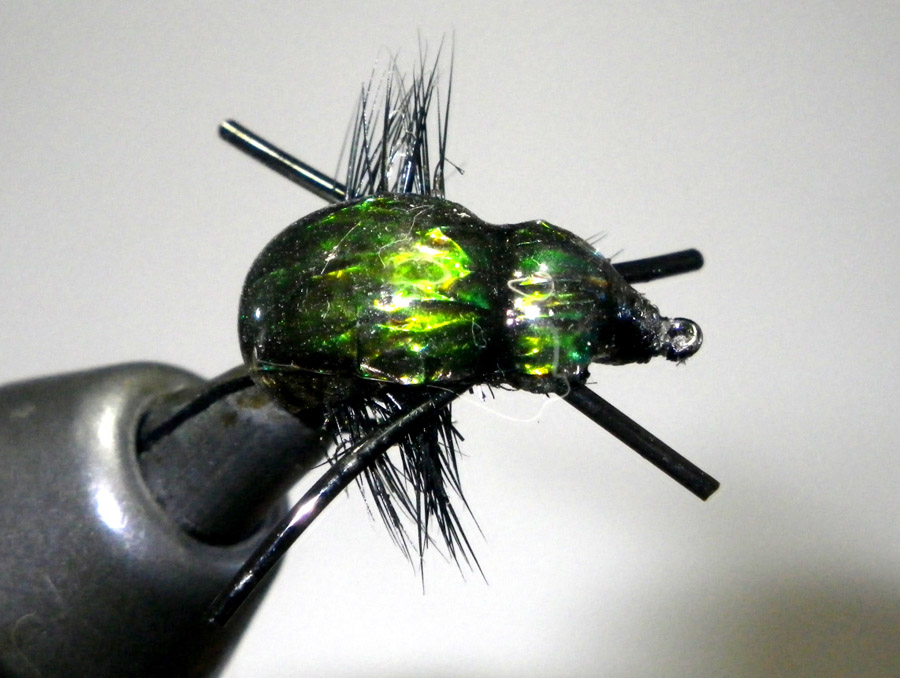
Alan Hobson’s version of the Good Doctor’s Beetle
Alan’s commercially available flies, tied to his specification by his gifted assistant, Juliana Johannes, are finding increasing favour with South Africa’s competitive fly fishers and he had an amusing experience while mooring his boat at Sterkfontein. He was approached by another angler, who introduced himself as a competitive fly fisher and was asked if he could see Alan’s Tadpole pattern.
It seems that at a recent competition one of the fly fishers on a dam had caught about ten fish when all his fellow competitors had been soundly skunked. As his rod kept bending into yet another trout, the other anglers became increasingly desperate in their entreaties of ‘What fly are you using?’ His reply, ‘A tadpole,’ was of little use to them.
It wasn’t just a tadpole, it was a HOT Fly (Hobson’s Original Tadpole), the result of years spent refining his imitation of the Platanna Tadpole but, as he constantly counsels, you have to fish it so that it mimics the behaviour of the natural.
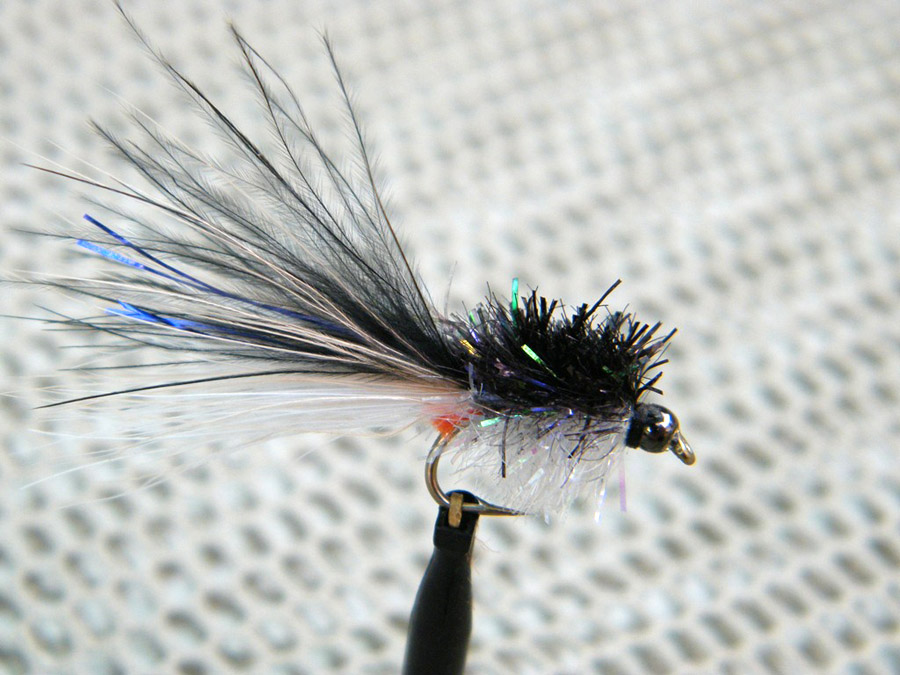
Hobson’s Original Tadpole - developed on the Mountain Dam in Somerset East
He says that a lot of anglers visit Somerset East because of its reputation for big trout and many have only one way of fishing - cast as far as possible, strip as fast as possible.
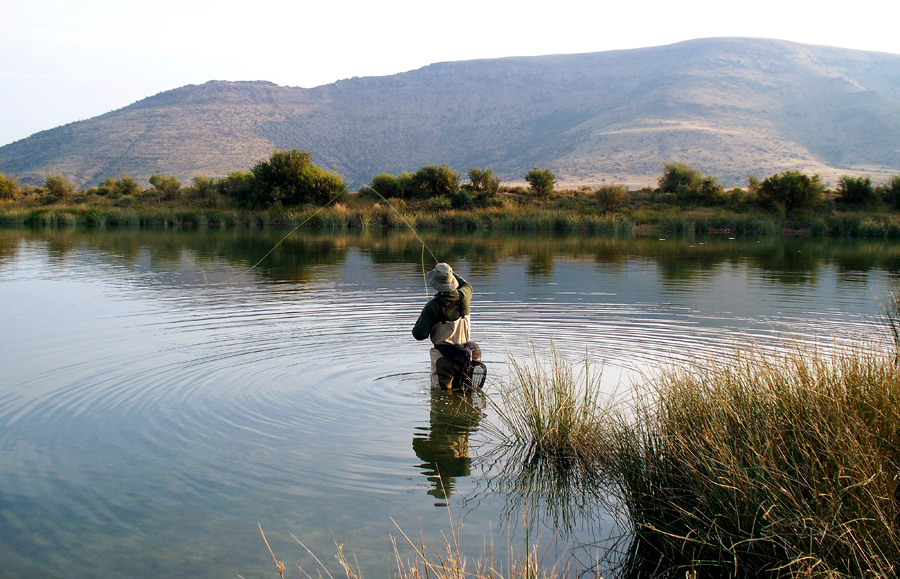
The Mountain Dam in Somerset East
This might appeal to the predatory instinct of trout but, he says, it is a method which denies its proponents a lot of the rich subtlety which is the reward of those who choose an imitative approach.
I experienced this when I fished Mountain Dam with him. He pointed out the clay banks and rocky outcrops (for crabs) and the weed beds (for dragon and damselfly nymphs and, in the evenings, caddis.) Near the inlet there are siltbeds where the chironomids live (bloodworm and, in the evenings, buzzers appear.)
He will, for example, fish his Mottled Dragon on an intermediate line with a floating poly leader, casting it onto the edge of the weed bed and letting it sit for a while before giving it a twitch which often results in an explosive strike because this is how the insect hunts. They lie in camouflaged ambush at the edge of the weed bed and then shoot out to grab passing prey.
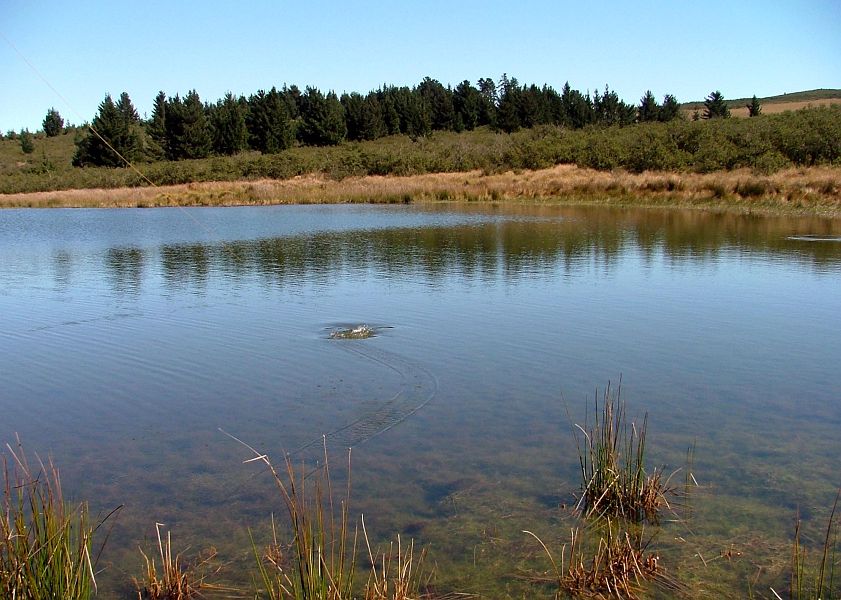
A twitch which often results in an explosive strike
Quote of the week
The heron is the teacher. He does not fish on general principles and neither do you, his student – not unless you want a humility lesson. You sneak up on one particular trout until you can see his spots. You figure out that it is taking duns in the surface film, and then you offer the fly it expects to see. You watch first and cast later.
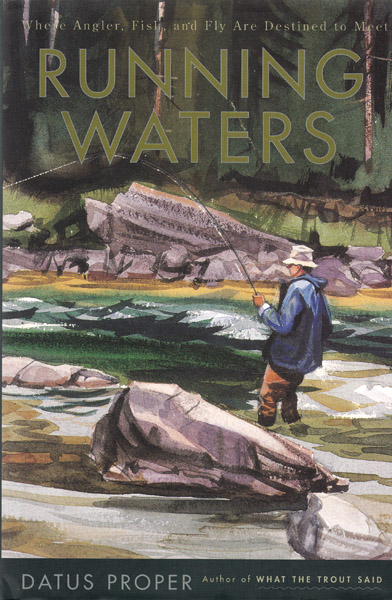
Datus Proper Running Waters
A lovely vignette from bamboo rod maker, Nick Taransky, in NSW, Australia
For the time being we are out of drought and the fish have made it through a mild summer. My friend Troy fished the same small creek for maybe 15 visits without a fish (saw them, spooked them, had flies rejected, hooked and broken off in the weeds etc etc), and then finally his perseverance paid off (a 6 1/4 and 5 1/2 pounder one trip, and another 5 1/2 pounder the next - all weighed and released from his NZ weigh-net, so no exaggeration).
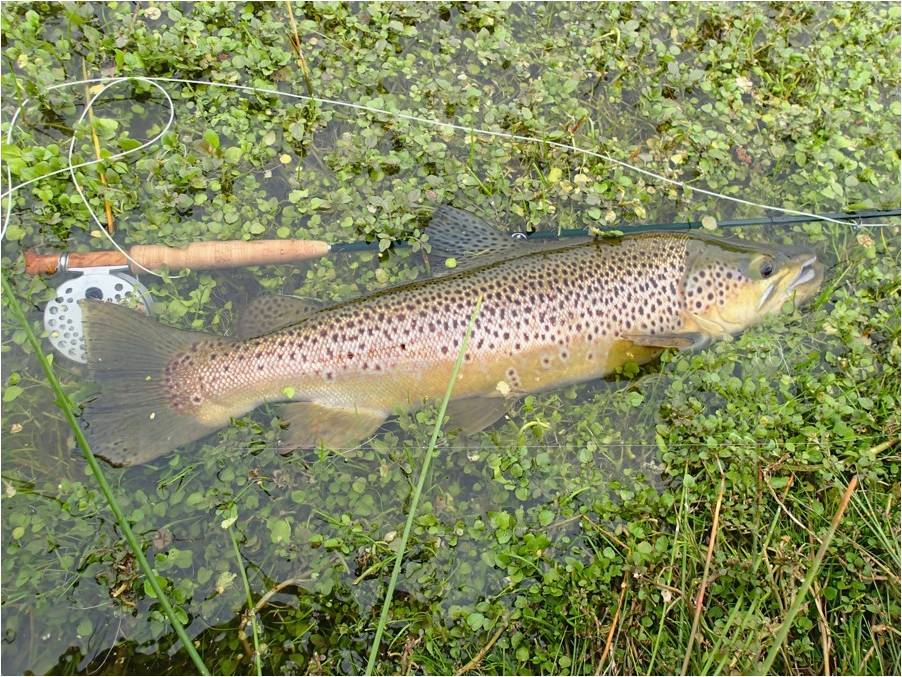
Troy’s 6 1/4 pounder.
I went to a different stream near there the another day (my first day out in two months). Lots of walking and spooking, and eventually the planets aligned and I landed a 23 inch buck with a big hooked jaw. One of those weathered old timers that could/should have weighed more but was gorgeous and had lovely colours and character. I think I fished to him last year, perched on a fallen log while crouching in the Tea Tree bushes ’til both of my legs were numb. Last year I got hooked in the Tea Tree, and leaning as far forward as I could, the log snapped, and in I went in over my head! That was that. This time I was on safer ground and after seeing him here and there, saw him rise and drift down in my direction. I flicked out a Turkey-winged dun and he came up took it face on to me. A lucky strike and the hook held in his lower mouth. No picture of my fish, sorry, but a couple of shots of the stream that I caught him in.
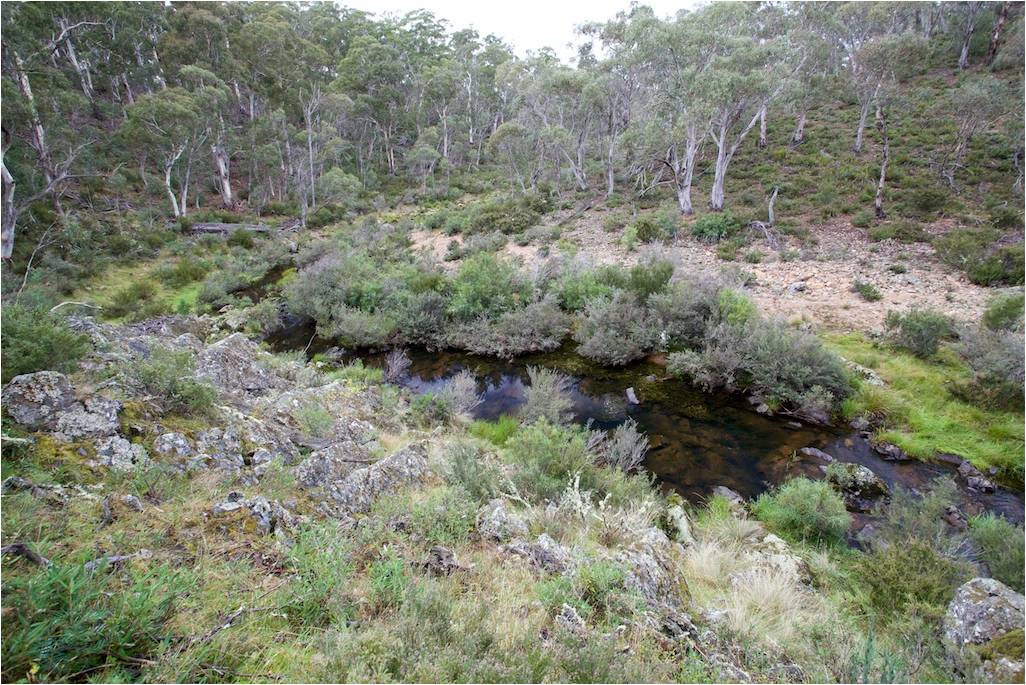
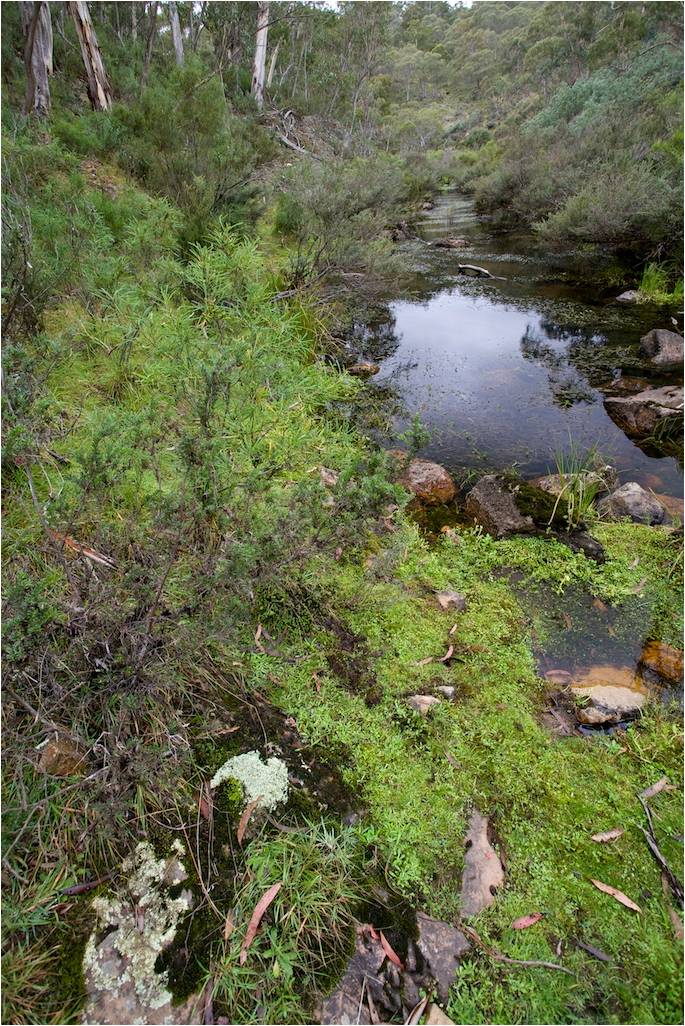
All granite boulders, weed and overhanging tea trees. I let him go and looked at my watch. It was only 2:30 pm. I could have fished on, but what could top that!
Images from Tony Kietzman of the Epson WTA fly fishing festival
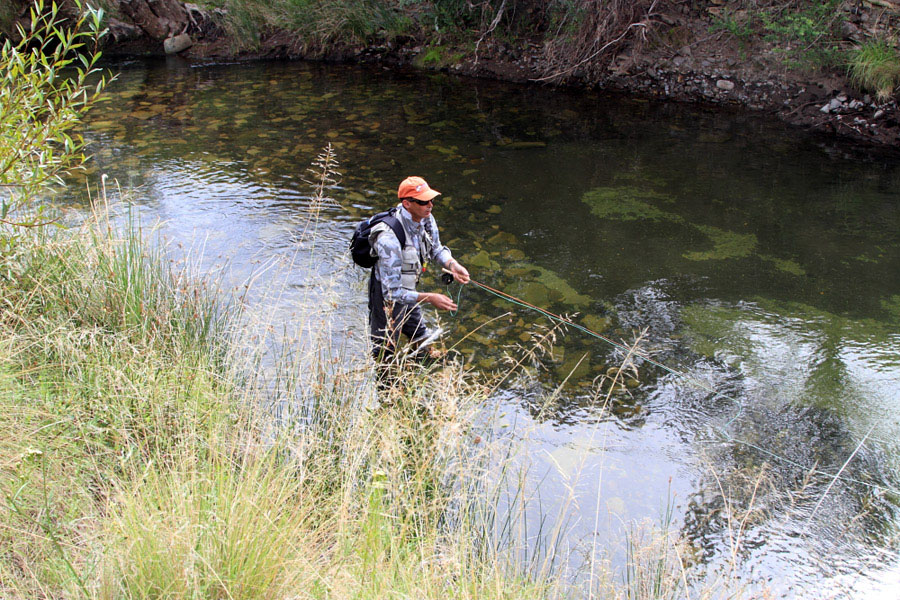
Martin Le Roux at Cleft Hill on the Bokspruit
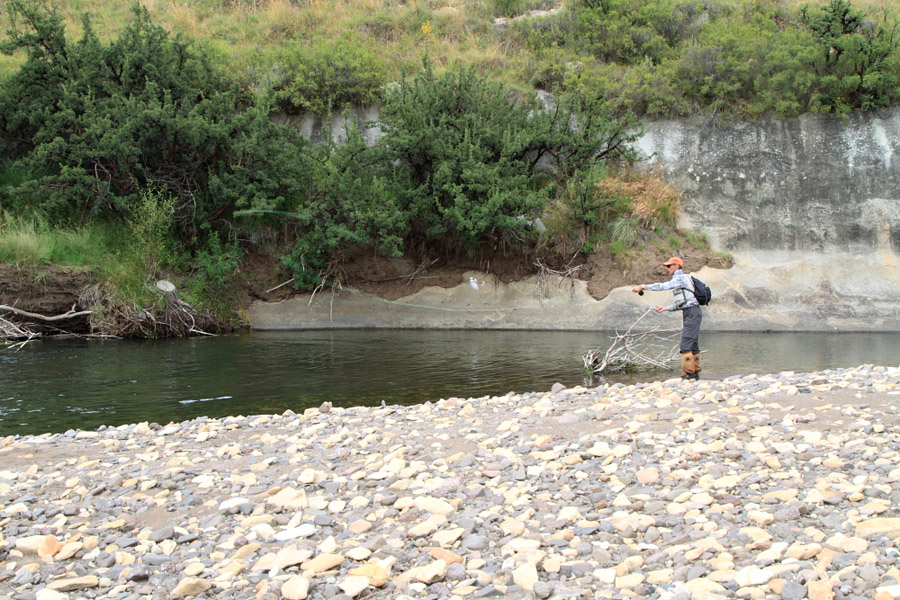
Martin Le Roux's antique Orvis bamboo at work
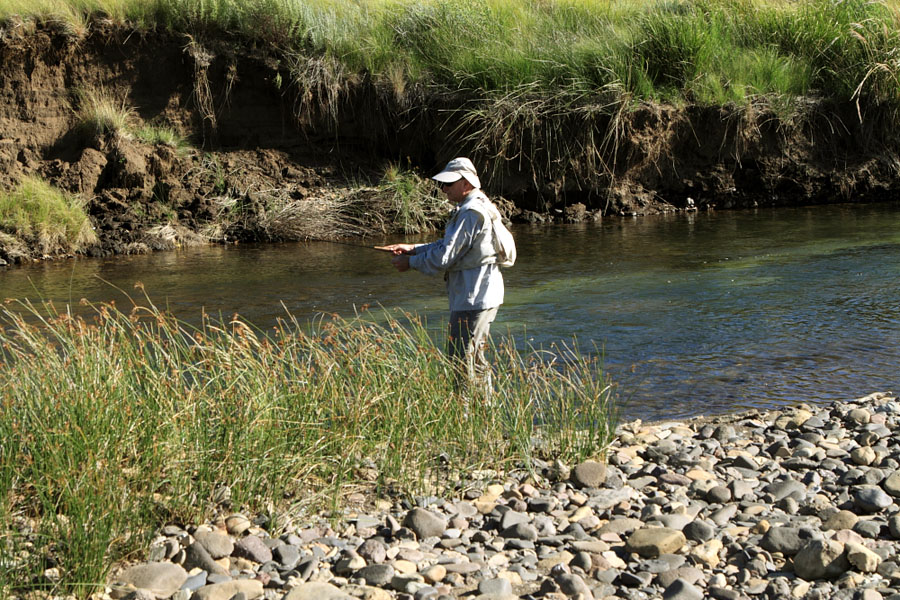
Richard Hancock at Clontarf on the Bokspruit (above and below)
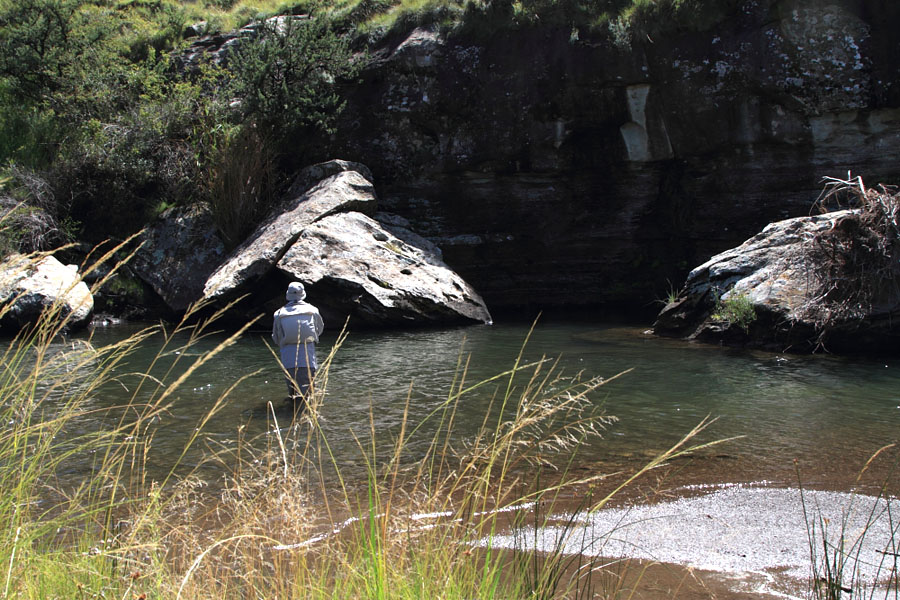

Russell Dickson and Martin Le Roux watch Wall Vorwerk fishing Cleft Hill
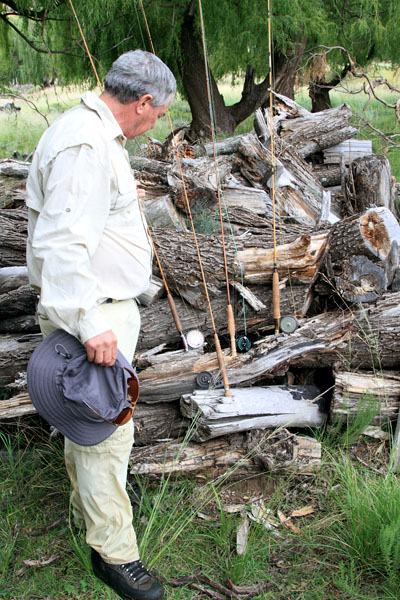
Russell admires the bamboo hardware at a stream side break

Willem Durant at Wildside on the Kraai (above and below)
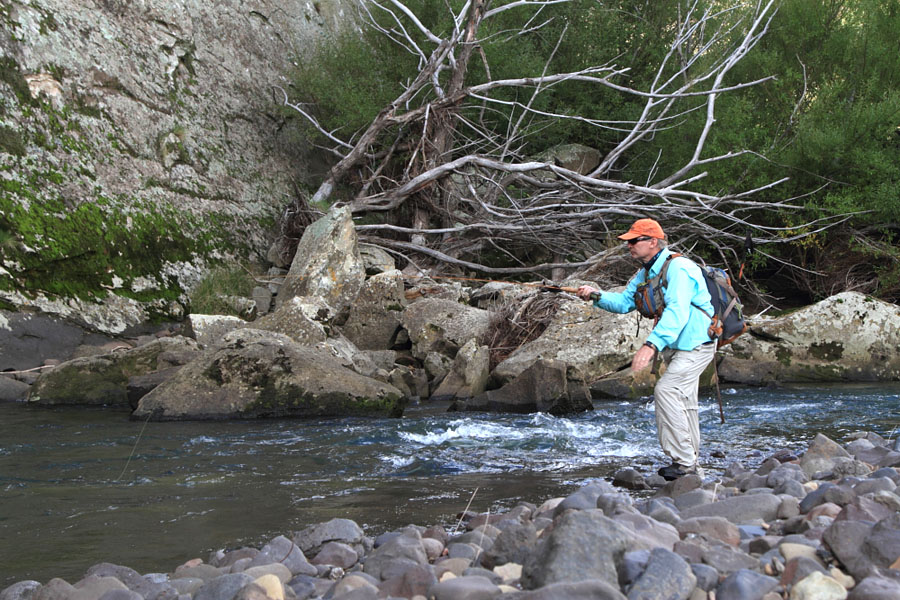
And from the WTA Festival from Jan Korrubel
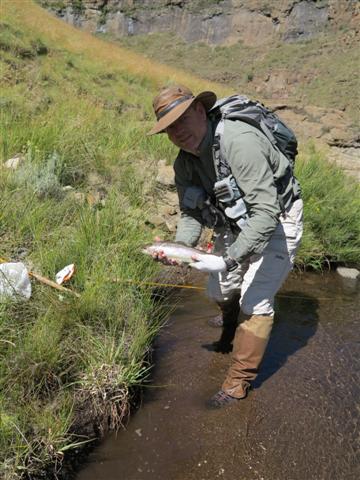
Mike McKeown’s Gateshead 14 “ Rainbow

Upper Bokspruit looking down on The Saddle and Castle
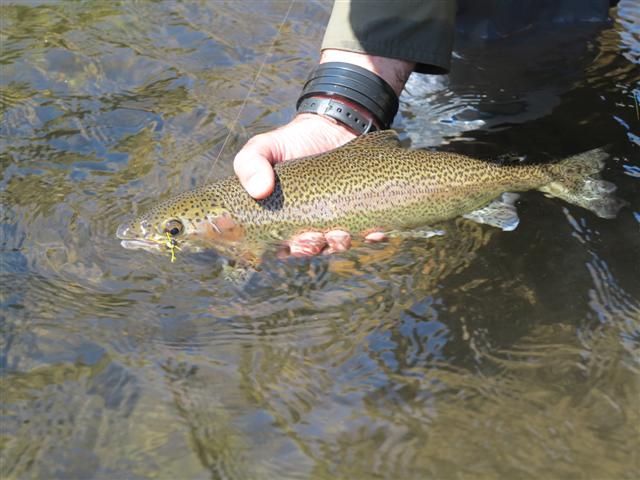
Jan Korrubel’s Gateshead Rainbow of15 inches. Photo by Mike McKeown
Images of the week – Tackling up!
You will have noticed that for most anglers, tackling up is a serious business undertaken with an air of self-absorbed, quiet concentration. Mostly it’s a tidy process, sometimes it’s a little scattered. But when you look at the faces of fly fishers setting up around you, they’ll look more like people studiously involved in some sacred ritual than someone involved in some minor, routine chore.

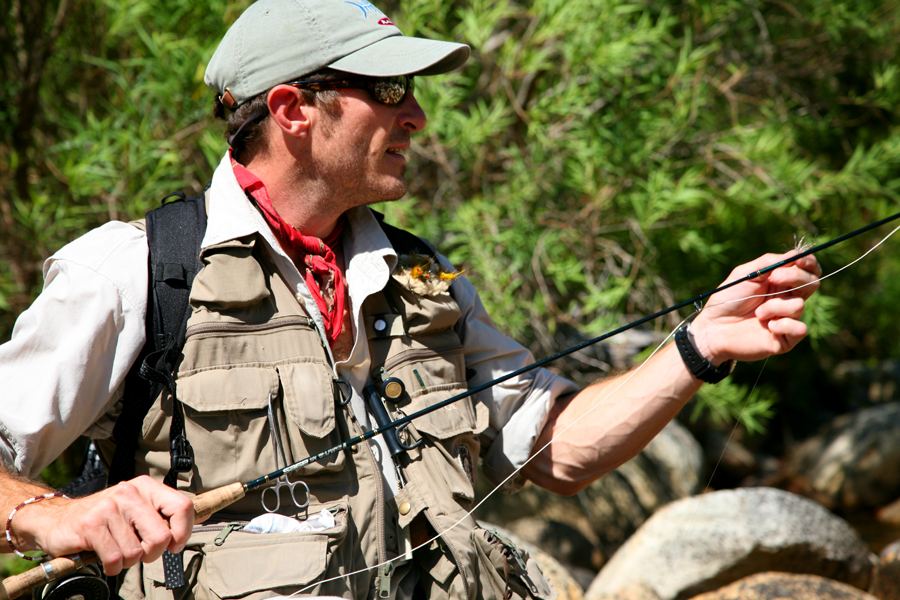
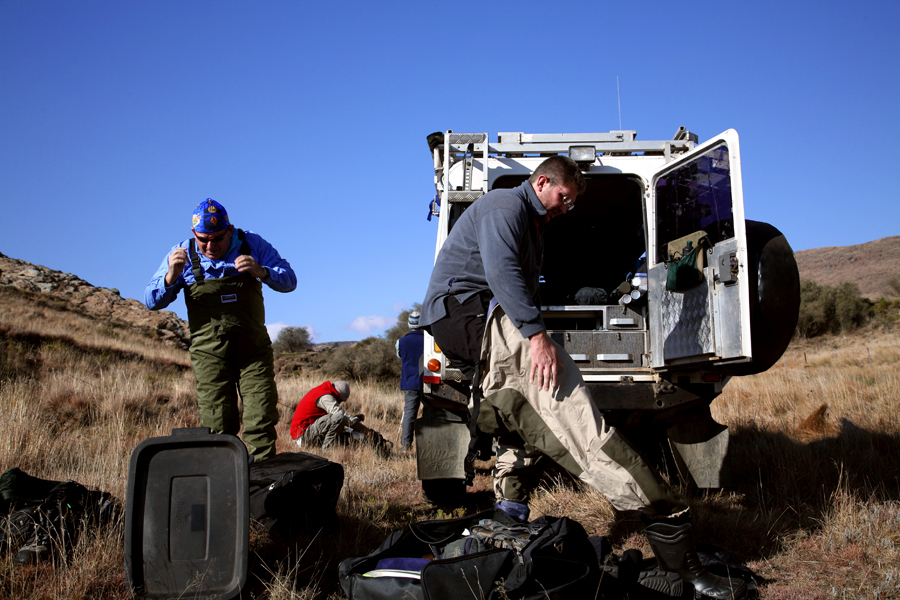

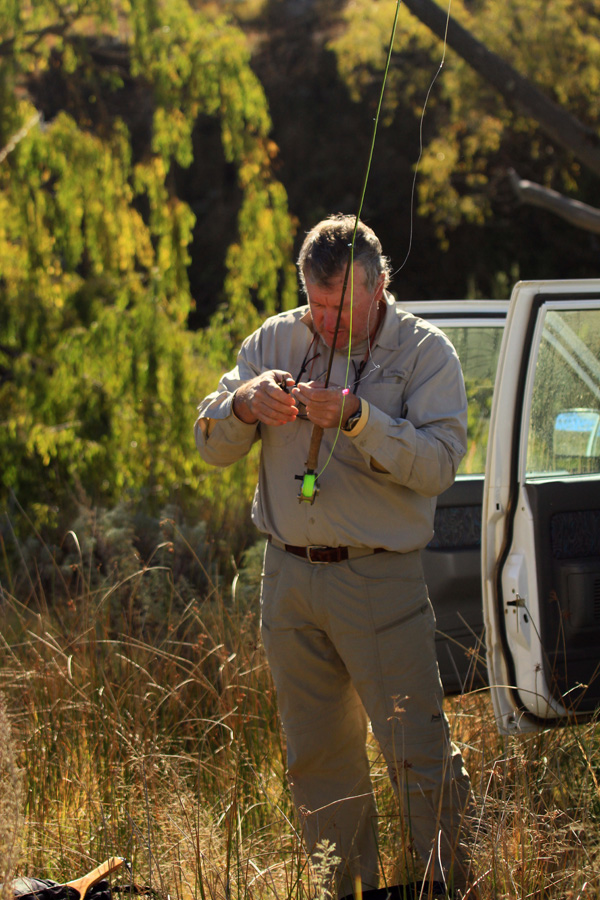
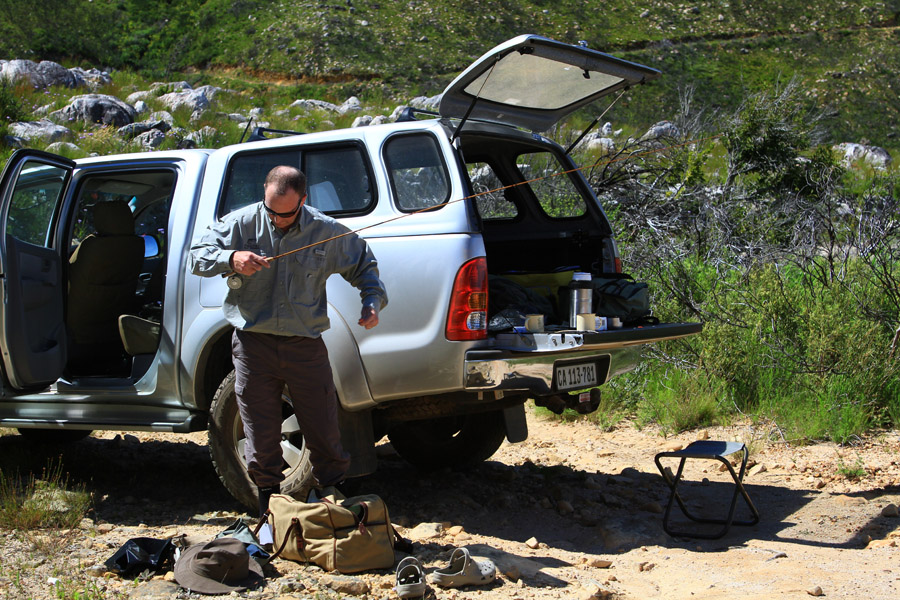
Answers to the GEM Skues questions
Was he born in London, Winchester, Ireland or Newfoundland?
A: Newfoundland.
Was he educated at Harrow, Winchester or Rugby School in London?
A: Winchester.
He was known for his excellent eyesight. Yes or no?
A: No. He had a damaged eye and needed a magnifying glass to tie on his flies.
Did he ever visit South Africa?
A: Yes, on a cruise ship!
Was GEM Skues a butcher, an attorney or an auditor, and where did he live his entire business life?
A: He was a London-based attorney all his business life.
He died aged 61, 78 or 91?
A: 91 years. And that despite reportedly refusing to take membership of the London Fly Fishers Club as his health was generally judge so ‘poor’ that he never thought he would live long enough to warrant joining!
He designed the PTN nymph. Yes or no?
No. Frank Sawyer designed the PTN.
He was a prolific writer whose nom de plume, or noms de plume, was/were, Val Conson, Spent Naturalist, Integer Vitae, WAG? A: All of these noms de plume were used by him from time to time.
He was introduced to Frank Sawyer? Yes or no?
A: Yes, he was.
Theodore Gordon who fished the Catskills in the USA wrote to Skues the day before he died. It was the last letter Theodore Gordon ever wrote. True of false?
A: True!
And so we live and learn!

